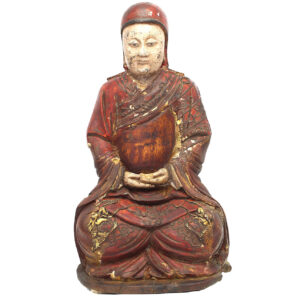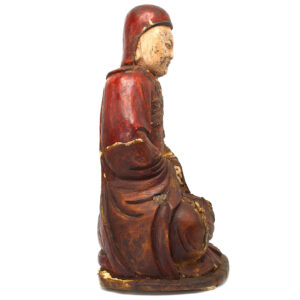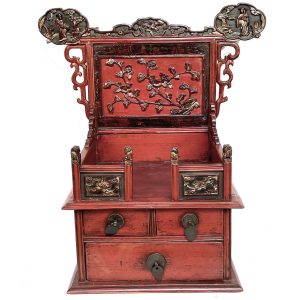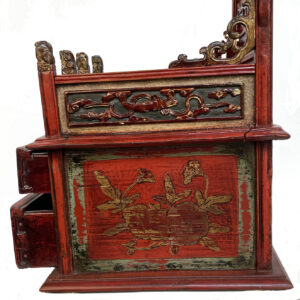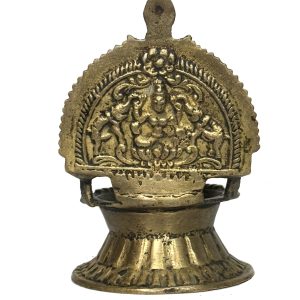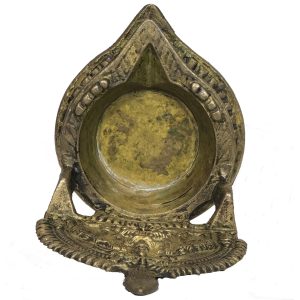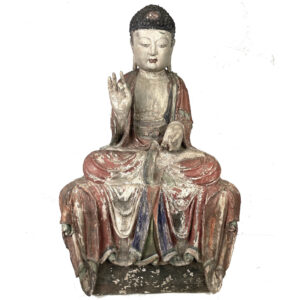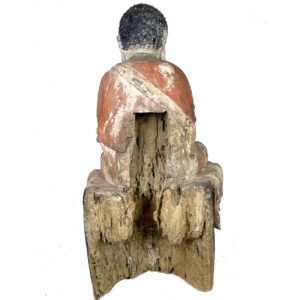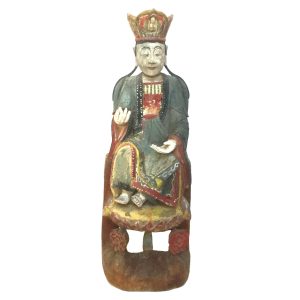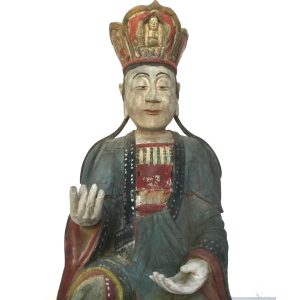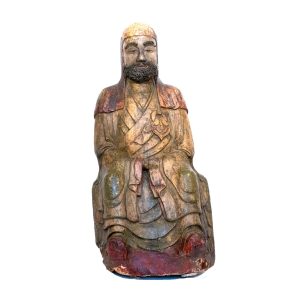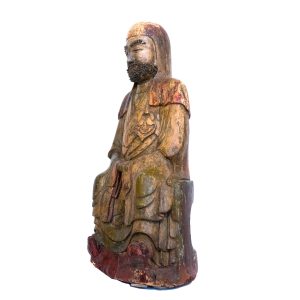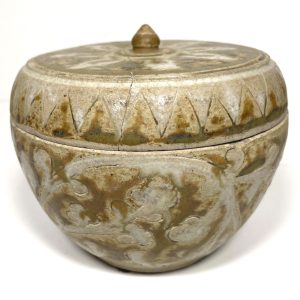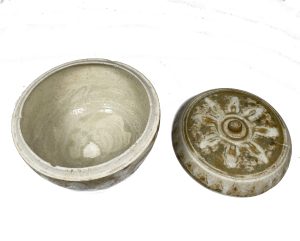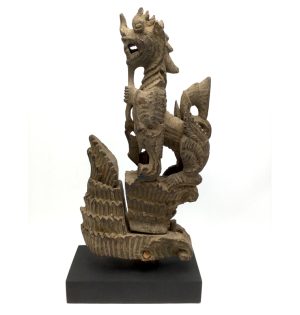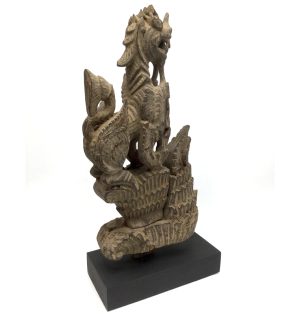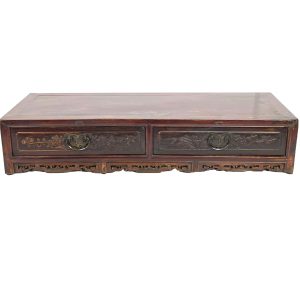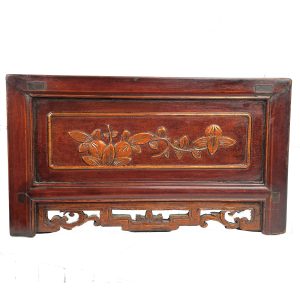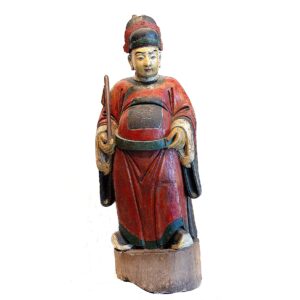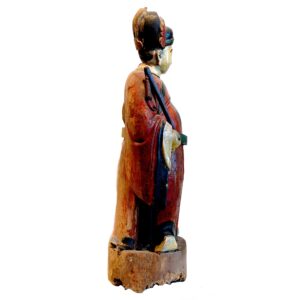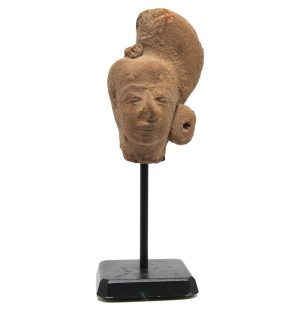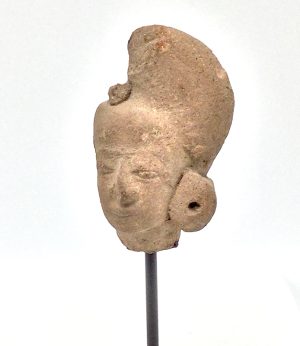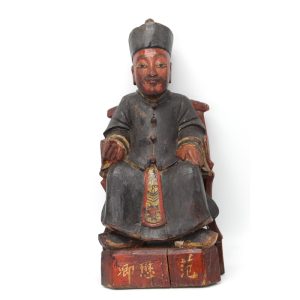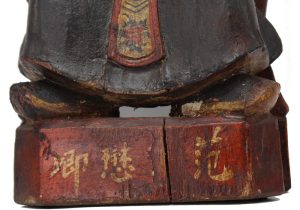Showing 97–108 of 313 results
-


$695.00
Early Chinese Mahayana images portrayed Lohans as followers of the Buddha, living in the human world in human forms .Through their spirituality and asceticism they achieved enlightenment and were no longer subject to rebirths but choose to not enter nirvana and remain as guardians to preserve Buddhist teachings, protect the Buddhist faith and lead others…
-
Sale!


$695.00 Original price was: $695.00.$495.00Current price is: $495.00.
Ht: 20.75” W: 19.125” D: 11” |CALL 213-568-3030 OR EMAIL [email protected] FOR SHIPPING COST
This very fine ladies vanity cabinet is covered with red lacquer, the color of blessings (fu), highlighted with gold and deeply carved and painted decorations of auspicious symbols to bring happiness, good fortune, long life and many sons to the elite couple who may have received it as a wedding gift by parents in hopes of them successfully carrying on the family tradition. This is a reflection of the Confucian belief having sons to carry on the family name is essential to real happiness.
-


$245.00
H: 5″ W: 3.25″ D:3.875″ | FREE SHIPPING WITHIN CONTINENTAL U.S.!
This brass oil lamp diya is decorated with an image on front and back of Lakshmi seated on a lotus, full-breasted and broad hipped, beneficently smiling and being lustrated (showered by water) by elephants, symbolizing rain clouds bringing water and life to the land and that unwavering effort to adhere to spiritual teachings and governed by wisdom and purity leads to both material and spiritual prosperity.
-
Sale!


$4,500.00 Original price was: $4,500.00.$2,959.00Current price is: $2,959.00.
H: 30″ W: 18″ D: 10″ | CALL 213-568-3030 FOR SHIPPING AND PRICE INFORMATION
This superb, colorful and rare carved Buddha is seated in vitarka-mudra, the teaching hand position. His delicately carved calm face has a benevolent and compassionate expression with a slight reassuring smile. The elegant body appears to float above deeply carved swirls reminiscent of clouds. Fine facial features, the graceful body and exquisitely carved and painted drapery make this a truly impressive and striking image. Given its size and masterful carving , it should hold a place and be revered commensurate with its spirituality and artistry.
-


$4,750.00
The close association of the lotus and Guanyin (Sanskrit Padmapani meaning “born of the lotus,”) is depicted in this Guanyin image sitting on a flat, round open yellow lotus padmapitha pedestal held up by a stem flanked by red lotuses facing out in a folk art tradition. As one of the Great Chinese Goddesses (Irvin),…
-


$7,300.00
The original 16 or18 arhats in Theravada Buddhism, later called Lohans in Mahayana Buddhism, were the original disciples of Gautama Buddha. Able to attain enlightenment and enter nirvana, instead they remained on earth to aid Buddhist devotees to reach nirvana. Buddhist temples are often lined with 18 lohan but there may be many more. Never…
-


$215.00
Ht: 4.25” Dia: 5” | FREE SHIPPING within continental U.S.!
Produced in Thai kilns in the 14th to 15th centuries, Sawankhalok glazed stoneware lidded bowls were distributed through Southeast Asia along with a variety of larger and smaller items. Lidded bowls like this were used to store many things, especially spices, powders and cosmetics, betel nut chewing materials, and medicine. This bowl rests on a thick foot, has a lid with a radiating glazed petals surrounding an olive-brown glazed lotus bud handle. The cover’s side has a band of pointed star points and the body is covered with an intricate scroll of white glazed colored branches and florals.
-


$325.00
H: 14.5” W: 17.75” D: 3.375” | FREE SHIPPING WITHIN CONTINENTAL U.S.!
Finely carved figures were attached to ox cart yokes to protect farmers from malevolent spirits who inhabited all seen/unseen sectors of their world. . This beautifully carved ox cart yolk image is a chinthe, a mythical Burmese lion/dragon creature commonly decorating many everyday items. A propitious spiritual and protective guardian, the animalsymbolizes power, courage, and strength. This carving displays the common traits of a lions with a long face, large eyes, a long sharp nose, a lion-like beard, and a flame-like shape on the top of his head. Masterfully carved with careful attention to details, see the deeply incised hairs that cover his body. The 2-part piece is held together with a wooden plug. Though for daily use, Burmese craftsmen created beautiful objects and finished them with the best materials they could afford.
-
Sale!


$595.00 Original price was: $595.00.$375.00Current price is: $375.00.
H: 5.625″ W: 27.875″ D: 9.75″ | CALL 213-568-3030 OR EMAIL [email protected] FOR SHIPPING
The low profile and fine lacquered finish of this charming antique wood chest add warmth and a touch of antique fine craftsmanship to any setting. The two intricately carved drawers for storage lend it to a multitude of uses. Carved auspicious symbols to bring the Five Blessings or Happinesses include peonies and vines, butterflies, plum blossom and a Japanese lily. The sides have inset panel with florals and the bottom has a decorative apron with a beautiful fretwork vine design. Its warm patina extends to the detailed brass butterfly handles.
-


$4,500.00
The Eight Immortals are folk heroes with supernatural powers who achieved immortality and became Taoist deities. They were probably actual people who were granted extraordinary powers after death. Since the 13th century they have been viewed as a fun loving group living in heavenly mountains and hills enjoying good food, wine, gambling and the opposite…
-


$195.00
Ht: 4” W: 1.5” D: 1.75”|FREE SHIPPING WITHIN CONTINENTAL U.S.!
This terracotta head was crafted during the Majapahit Empire in Java and was either part of a Hindu bas-relief frieze or made as a freestanding figurine. Most figures found are small decapitated heads with no bodies, and it is very rare to find a complete figure with a naturalistic facial expression. As with many heads, this one displays Javanese facial features, hairstyles and ear ornamentation typical of the period. It has a naturalistic facial expression and wears large round coiled earrings, possibly suggesting it represented someone of the upper classes. It is in very good condition given its age and use and is mounted on a metal stand. This items pairs with Majapahit Terracotta Head 1137.
-


$450.00
Designation as civilian Mandarin officials was so significant that families fervently sought to perpetuate this image through generations in carved and painted ancestral renderings, especially ancestor-figures. This civilian official sits in the traditional official’s pose with arms on short armrests in an an ornately carved high back chair, curved backrest, tall legs and vertical slats…
End of content
End of content

